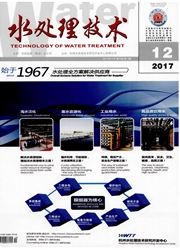

 中文摘要:
中文摘要:
针对地下水中硝酸盐污染,提出了废铁屑与颗粒活性炭联用,开展了修复模拟硝酸盐地下水的批试验研究。结果表明,铁炭总量为8.0~10.0g时,残留NO3^-为34.23~35.21mg·L^-1,此时介质用量为最佳值。介质粒径对NO3^-去除效果的影响不明显。反应时间从1h增至5h,水相pH由初始值6.42增至7.09。中性时铁炭联用可以保持水相pH的稳定。在弱酸性条件下,只有特定的金属氧化物对NO3^-去除具有促进效果,5种氧化物均导致水相中NO2^-和NH4^+增加。铁炭联用的修复机理包括化学还原、原电池反应、絮凝(共)沉淀、电泳富集和吸附,是一种经济有效修复硝酸盐地下水的方法。
 英文摘要:
英文摘要:
According to nitrate contamination in groundwater, the combination of waste iron chips and granular activated carbon particles was proposed. Batch experiments were conducted to remediate the simulated nitrate-contaminated groundwater. The results show that the residual NO3 is 34.23 35.21 mg·L^-1 at the iron and activated carbon total amount of 8.000 0- 10.000 0 g which is considered as the optimum value. Particle size hasn't an ob- vious impact on NO3 removal efficiency. The pH value increases from the initial 6.42 to the final 7.09 with reaction time from 1 h to 5 h. Iron mixed with activated carbon can keep pH value steady at neutral condition. Only special metal oxides can promote NO3 removal at weak acidic condition. All of the five oxides result in the increase of NO2 and NH4^+ in water phase. The remediation mechanisms related to the mixture of iron allied with activated carbon include chemical reduction, galvanic cell reaction, coagulation & (co-)precipitation, electrophoretic accumulation and adsorption. This approach is a cost-effective one to remediate nitrate- contaminated groundwater.
 同期刊论文项目
同期刊论文项目
 同项目期刊论文
同项目期刊论文
 Anaerobic Biodegradation of Tetrachloroethylene with Acetic Acid as Cometabolism Substrate under Ana
Anaerobic Biodegradation of Tetrachloroethylene with Acetic Acid as Cometabolism Substrate under Ana Laboratory study on the reductive dechlorination of tetrachloroethylene in natural anaerobic conditi
Laboratory study on the reductive dechlorination of tetrachloroethylene in natural anaerobic conditi Removal of trichloroethylene in groundwater using heterogeneous modified Fenton chemical oxidation t
Removal of trichloroethylene in groundwater using heterogeneous modified Fenton chemical oxidation t 期刊信息
期刊信息
